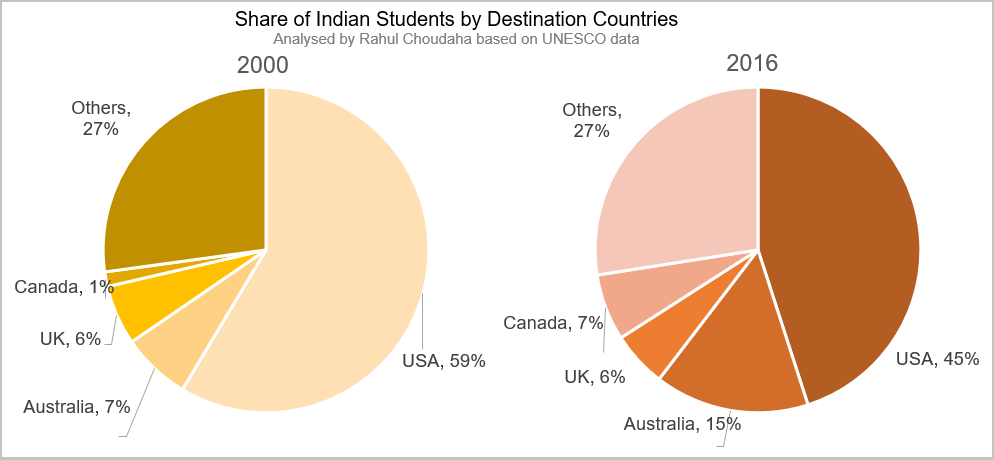Mobility of Indian Students: Preparing for Future Growth
“The majority of Indian students are highly-price-sensitive, value-maximisers who are trying to search for options that lower cost and increase career opportunities”
In this blog, executive vice president of global engagement and research at Studyportals, Rahul Choudaha, explores the issue of whether the number of Indian students studying abroad will continue to grow in the current political and economic environment.
More than 5 million international students were studying outside their home country in 2016. With over 300,000 Indian students studying overseas, India is the second-largest source of international students after China.
However, in the recent times, the political turmoil triggered by the results of the UK’s referendum to leave European Union or Brexit and the American Presidential elections has also created an environment of restrictive immigration and visa policies in two leading destinations. Will the number of Indian students studying abroad continue to grow in this environment?
A shift in destination preferences
The total number of Indian students overseas increased from 66,713 in 2000 to 301,406 in 2016, based on the analysis of data from the UNESCO Institute of Statistics. This translates into 234,693 more students overseas in 2016 as compared to that in 2000—at a robust average annual growth rate of 22% in a span of 16 years.
While the overall number of Indian students abroad has increased, it also experienced a phase of decline as an aftereffect of the global financial recession. The number of Indian students reached its peak of 210,649 in 2010 and then declined until 2013 to reach 190,358 students. Since then Indian students overseas started growing again to cross 3,00,000 in 2016.
Between 2000 and 2016, the share of Indian students in the US dropped from 59% to 45% and the UK remained stagnant at 6%. In contrast, Australia more than doubled from 7% to reach 15% and Canada zoomed from 1% to 7%. In other words, much of the growth in demand to study overseas was absorbed by Australia and Canada at the expense of the US and the UK.
Influence of immigration policies
One of the biggest reasons for this shift in the share of Indian student overseas had been the pro-immigration policies and post-study work rights in Canada and Australia. The majority of Indian students are highly-price-sensitive, value-maximisers who are trying to search for options that lower cost and increase career opportunities. And, hence they are more sensitive to immigration and work policies.
For example, Canada’s Post-Graduation Work Permit Program (PGWPP) introduced in 2006 allows students to gain work experience which qualifies for permanent residency in Canada. Likewise, from 1999 onwards, Australia’s point-based immigration policies were designed to encourage international students to pursue a permanent residency in Australia.
On the flip side, UK’s abolition of post-study work rights, the number of Indian students has plummeted from a peak of 38,677 in 2011 to 16,655 in 2016. This steep decline was so sharp that the number of Indian students in the UK in 2016 was same as that in 2005.
A new segment of aspirations
The future demand for international education remains strong among Indian students. According to Studyportals, which received over 17.7 million and 5.7 million global users in 2018 searching for master’s and bachelor’s programs to study overseas experienced an increase of 37% and 77% respectively from users located in India.
While the demand is strong, visa and cost barriers are limiting the growth potential. India is at an inflexion point where two broad segments of students are emerging. The first segment is the traditional segment of price-sensitive, value-maximiser. The other emerging segment is the prestige-conscious, experience-seeker.
While the demand is strong, visa and cost barriers are limiting the growth potential”
Value-maximisers will continue to search for options which offer more “value for money” mostly through master’s programmes in STEM fields. For example, in addition to traditional destinations, this segment will seek alternative destinations in the Middle East, Asia and Continental Europe offerings English-taught Programmes.
The new emerging segment of experience-seekers will seek diverse fields and even start at the undergraduate level. These students have higher financial resources to fund their education and are relatively less concerned about immigration and immediate work opportunities. Consider the growth in the number of Indian undergraduate students at University of British Columbia from 200 to 726 students — a 263% increase in just four years between 2013/14 and 2017/18.
In sum, the demand for overseas education remains strong among Indian students. Universities and nations which recognize the diverse needs and expectations of student segments will be able to design effective strategies to recruit and engage Indian students.
This blog is an adapted version of the article first published in CNBC TV18.

Hi
i read your post very carefully . really Studying abroad is surely the best thing that can happen in a student life. Exploring a new culture, learning a new language, trying different cuisines making new friends while you’re still studying. Either you do it or regret all your life because you can’t just have the same experience once you have a job or get married. It’s freedom to the fullest.
thanks for sharing for useful information.